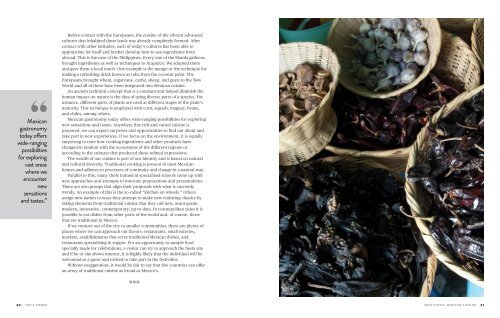ven-a-comer-e-book-en_1
ven-a-comer-e-book-en_1
ven-a-comer-e-book-en_1
Create successful ePaper yourself
Turn your PDF publications into a flip-book with our unique Google optimized e-Paper software.
Mexican<br />
gastronomy<br />
today offers<br />
wide-ranging<br />
possibilities<br />
for exploring<br />
vast areas<br />
where we<br />
<strong>en</strong>counter<br />
new<br />
s<strong>en</strong>sations<br />
and tastes.”<br />
Before contact with the Europeans, the cuisine of the vibrant advanced<br />
cultures that inhabited these lands was already completely formed. After<br />
contact with other latitudes, each of today’s cultures has be<strong>en</strong> able to<br />
appropriate for itself and further develop how to use ingredi<strong>en</strong>ts from<br />
abroad. This is the case of the Philippines. Every one of the Manila galleons<br />
brought ingredi<strong>en</strong>ts as well as techniques to Acapulco. We adopted them<br />
and gave them a local touch. One example is the mango or the technique for<br />
making a refreshing drink known as tuba from the coconut palm. The<br />
Europeans brought wheat, sugarcane, cattle, sheep, and goats to the New<br />
World and all of these have be<strong>en</strong> integrated into Mexican cuisine.<br />
An anci<strong>en</strong>t technical concept that is a constant and helped diminish the<br />
human impact on nature is the idea of using diverse parts of a species. For<br />
instance, differ<strong>en</strong>t parts of plants are used at differ<strong>en</strong>t stages of the plant’s<br />
maturity. This technique is employed with corn, squash, maguey, beans,<br />
and chiles, among others.<br />
Mexican gastronomy today offers wide-ranging possibilities for exploring<br />
new s<strong>en</strong>sations and tastes. Anywhere this rich and varied cuisine is<br />
prepared, we can expect surprises and opportunities to find out about and<br />
take part in new experi<strong>en</strong>ces. If we focus on the <strong>en</strong>vironm<strong>en</strong>t, it is equally<br />
surprising to note how cooking ingredi<strong>en</strong>ts and other products have<br />
changed in tandem with the ecosystems of the differ<strong>en</strong>t regions or<br />
according to the cultures that produced these refined expressions.<br />
The wealth of our cuisine is part of our id<strong>en</strong>tity and is based on natural<br />
and cultural diversity. Traditional cooking is pres<strong>en</strong>t in most Mexican<br />
homes and adheres to processes of continuity and change in a natural way.<br />
Parallel to this, many chefs trained in specialized schools come up with<br />
new approaches and attempts to innovate preparations and pres<strong>en</strong>tations.<br />
There are also groups that align their proposals with what is curr<strong>en</strong>tly<br />
tr<strong>en</strong>dy. An example of this is the so-called “kitch<strong>en</strong> on wheels.” Others<br />
assign new names to ways they attempt to make new <strong>en</strong>during classics by<br />
taking elem<strong>en</strong>ts from traditional cuisine that they call new, avant-garde,<br />
modern, innovative, contemporary, up-to-date. In cosmopolitan cities it is<br />
possible to eat dishes from other parts of the world and, of course, those<br />
that are traditional in Mexico.<br />
If we <strong>v<strong>en</strong></strong>ture out of the city to smaller communities, there are pl<strong>en</strong>ty of<br />
places where we can approach our flavors: restaurants, small eateries,<br />
markets, establishm<strong>en</strong>ts that serve traditional Mexican dishes, and<br />
restaurants specializing in supper. For an opportunity to sample food<br />
specially made for celebrations, a visitor can try to approach the fiesta site<br />
and if he or she shows interest, it is highly likely that the individual will be<br />
welcomed as a guest and invited to take part in the festivities.<br />
Without exaggeration, it would be fair to say that few countries can offer<br />
an array of traditional cuisine as broad as Mexico’s.<br />
■■■<br />
30 — V<strong>en</strong> a Comer Traditional Mexican Cuisine — 31


